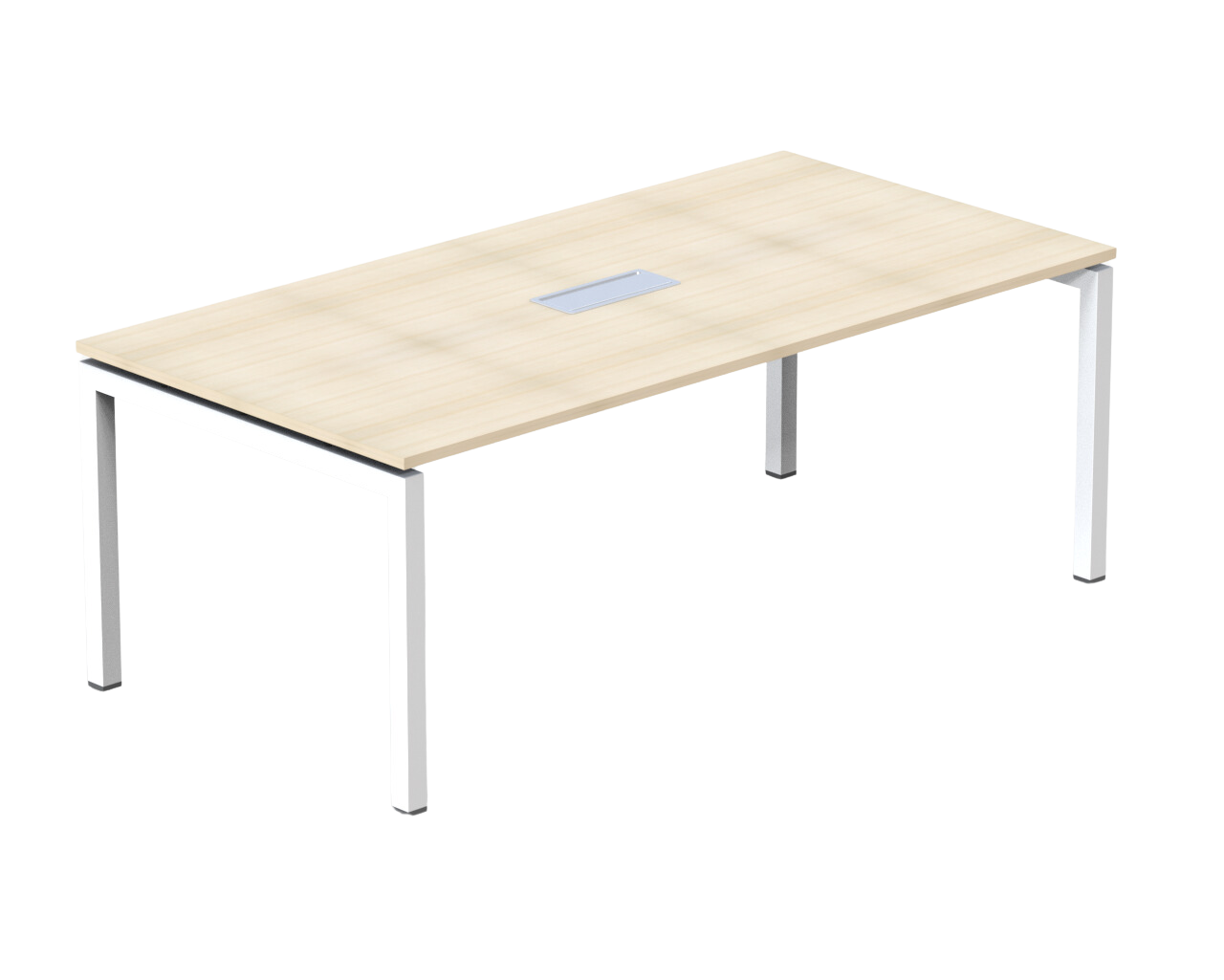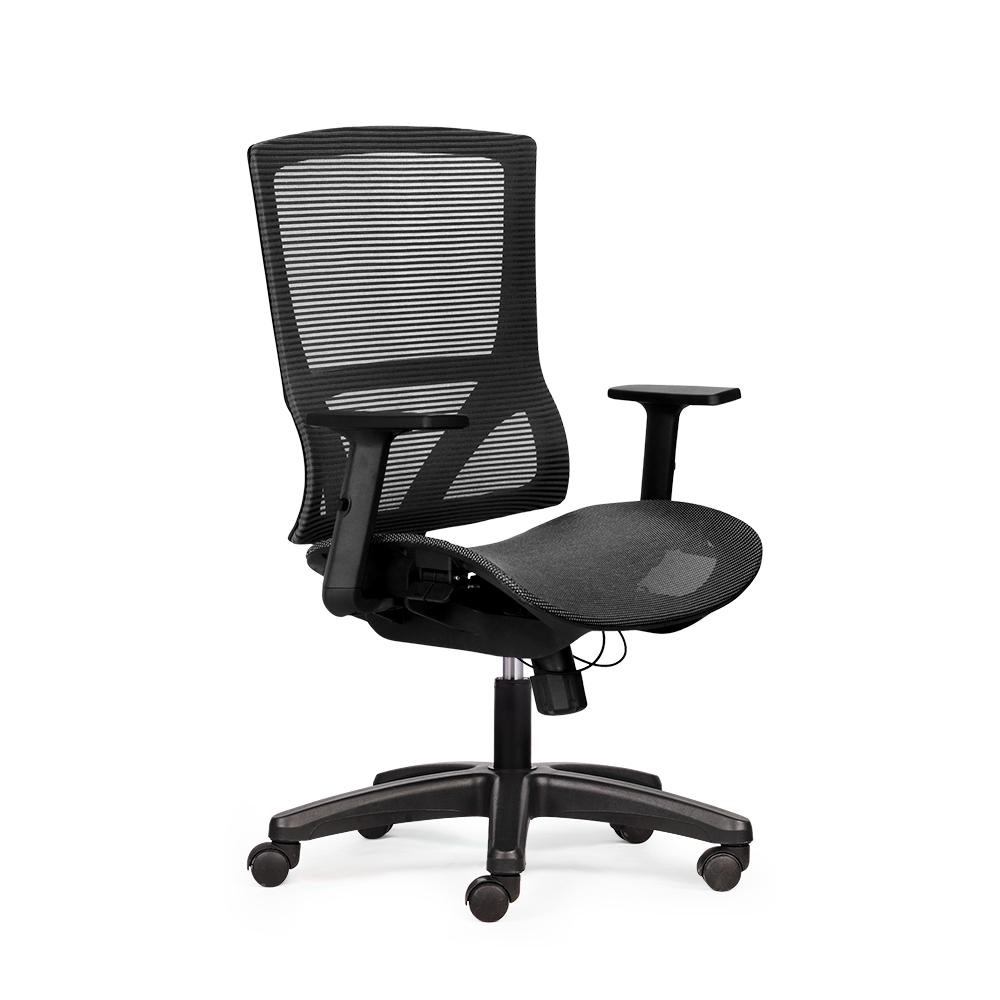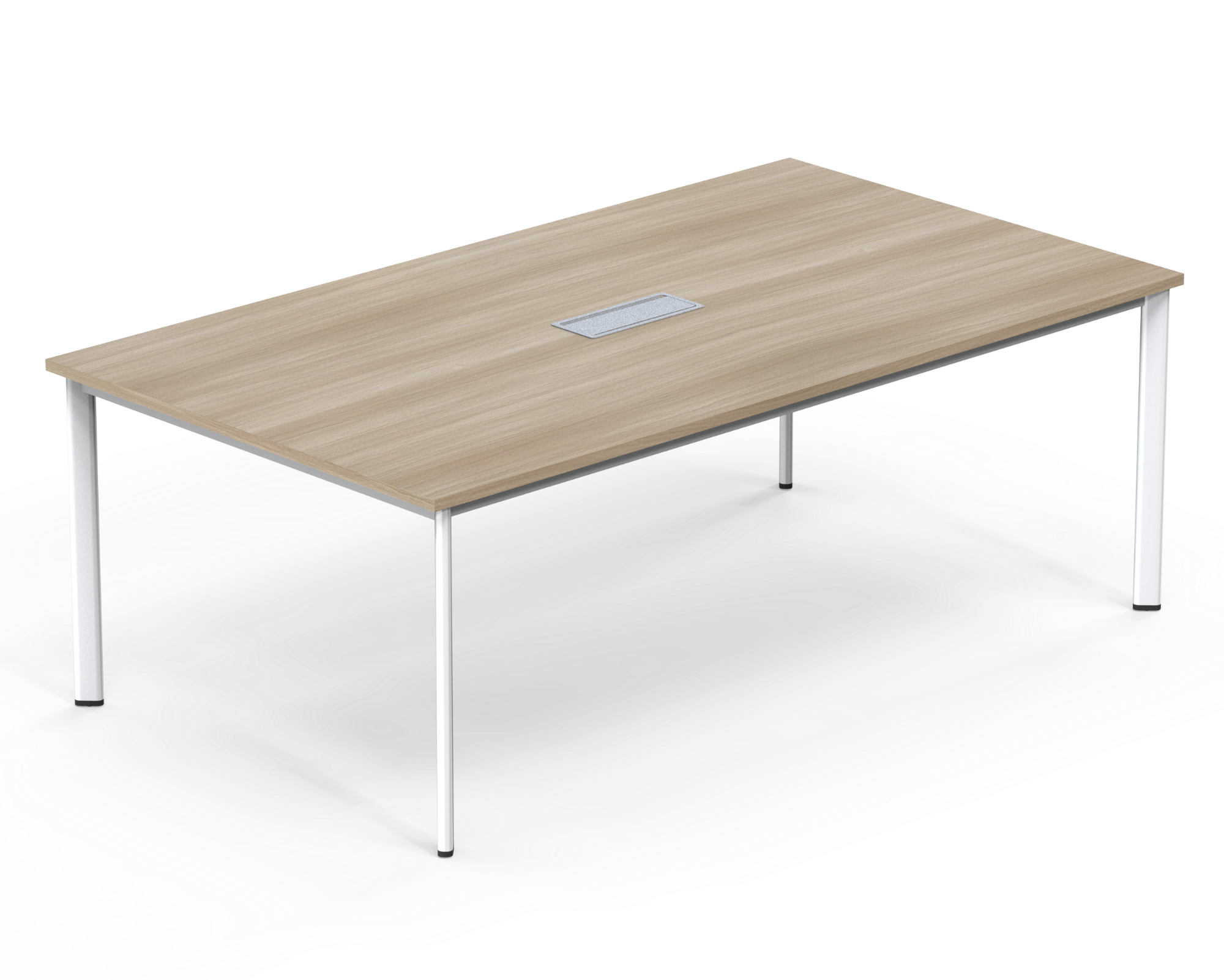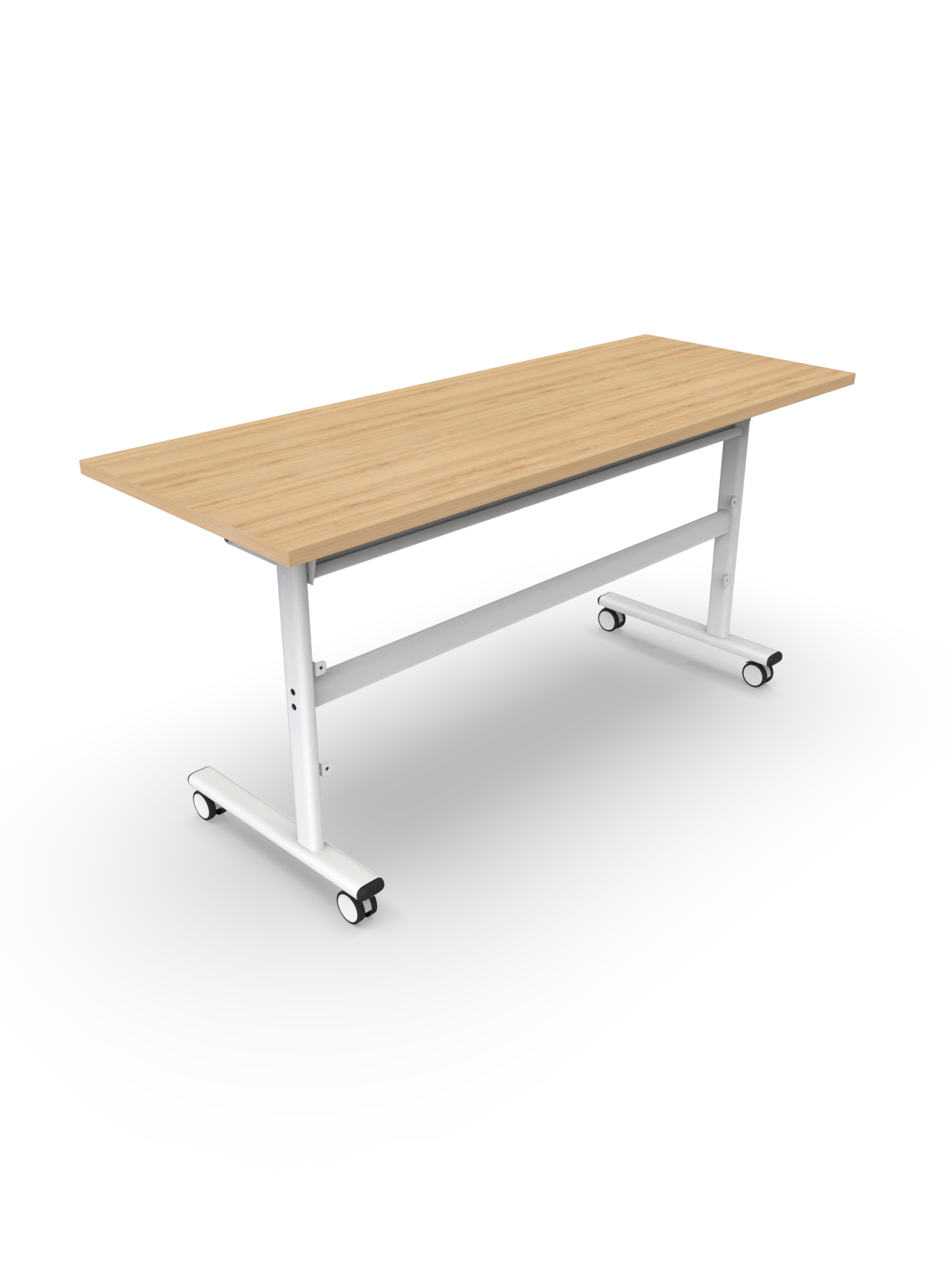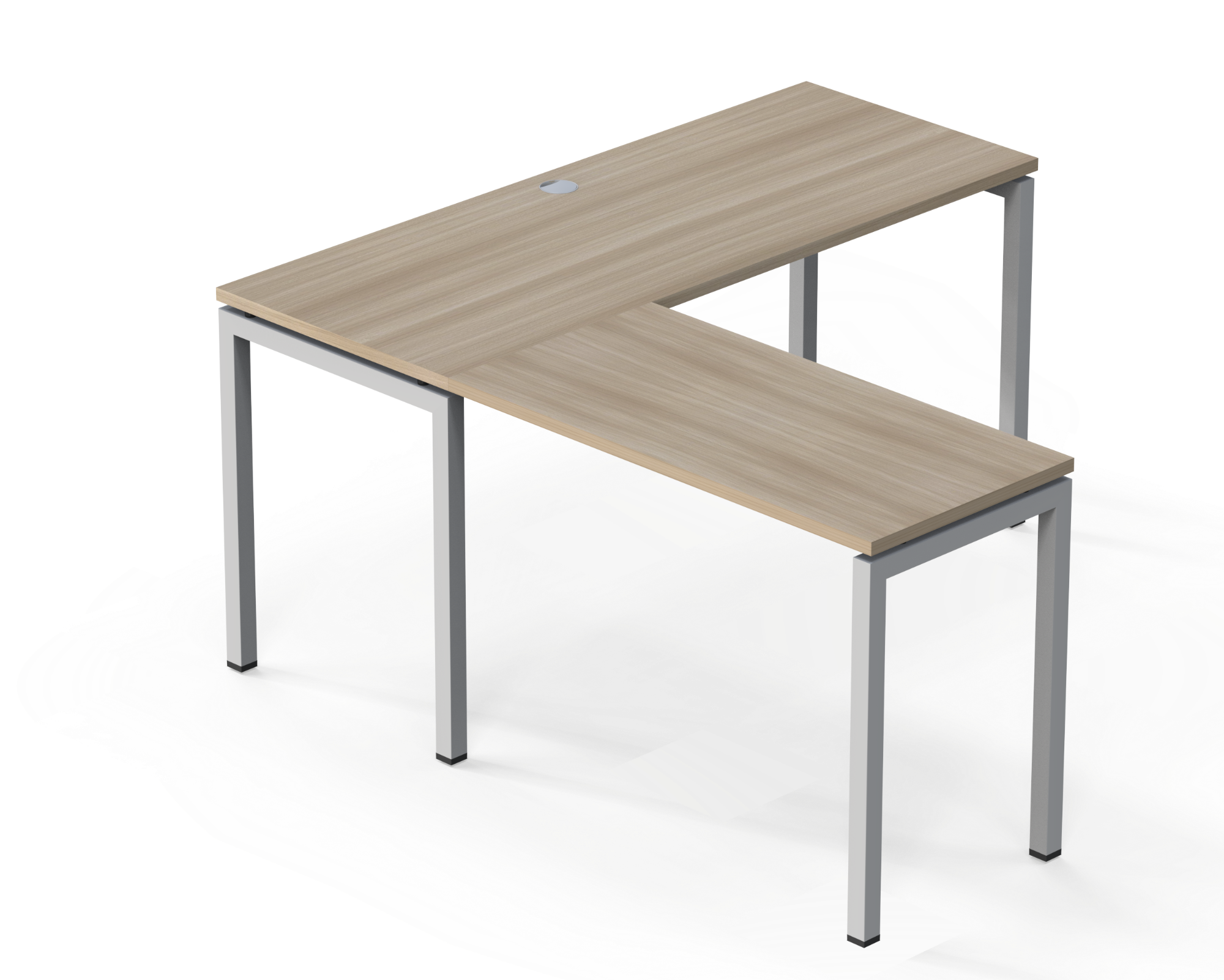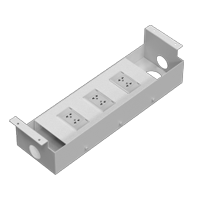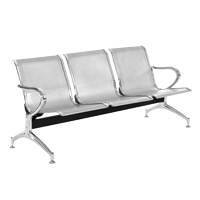
3 meeting table design mistakes that make your meeting room feel cramped and outdated
A meeting room is not only where important discussions and decisions take place, but also a space that reflects the “face” of the company. A modern and professional meeting room helps inspire employees while leaving a positive impression on clients and partners. However, during the design and furnishing process, many businesses make mistakes when choosing a meeting table, making the room look cramped, unbalanced, or lacking in functionality. These seemingly small errors can significantly affect both meeting efficiency and brand image.
In this article, The Mia highlights the three most common mistakes and provides practical solutions so that your meeting room is not only optimized for usability but also showcases sophistication and long-term vision.
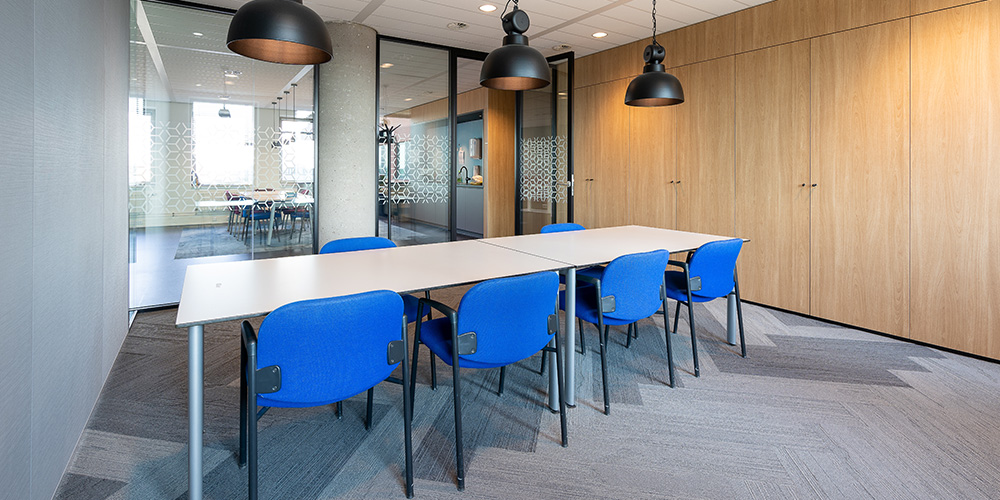
1. Choosing a table that is too large or too small for the room
Consequences of an ill-fitting table
One of the most common mistakes is choosing a table that does not match the size of the meeting room. If the table is too large, it occupies nearly all the available space, making the room feel stuffy and restricting movement. This also limits the ability to arrange additional equipment such as projectors, whiteboards, or storage cabinets.
On the other hand, a table that is too small leaves the room looking empty and unbalanced. It may not provide enough seating for larger meetings, leading to uncomfortable situations where people have to squeeze in. Worse still, a small table in a spacious room disrupts the sense of proportion, making the space feel awkward rather than impressive.
How to fix it
To avoid this, businesses should take precise measurements of the meeting room and determine the average number of participants. For example:
-
Small meeting rooms (6–10m²): A round or oval table with a diameter of 1.2–1.8m is appropriate.
-
Medium meeting rooms (10–20m²): A rectangular table 2.4–3m long paired with fixed or cantilever chairs creates balance.
-
Large meeting rooms (20m²+): Rectangular or U-shaped tables over 4m long allow enough seating for executive meetings or client presentations.
Choosing the right size table ensures the room feels airy, easy to move around, and comfortable for everyone involved.
2. Using outdated and unattractive table designs
Signs of an outdated table
Many offices still rely on heavy wooden tables with bulky legs and dark finishes. While these may look “imposing,” such designs are outdated and make the room feel heavy and uninspiring. If the meeting table doesn’t align with the overall office style, the space will feel mismatched and less professional.
Another common issue is sticking with the classic rectangular table shape. While practical, this layout often feels rigid, limiting interaction and failing to reflect the collaborative spirit of modern work culture.
Modern table trends worth considering
To modernize your space, consider lighter, more versatile designs such as metal-leg tables with engineered wood or veneer tops. Neutral colors like white, light oak, or soft gray are trending, making the room appear brighter and more spacious.
-
Round and oval tables encourage openness and equality, reducing hierarchy during discussions.
-
U-shaped or extended rectangular tables are perfect for larger teams, allowing better visibility and communication.
By following these trends, your meeting room becomes more welcoming and aligned with today’s dynamic workplace culture, while also showcasing your company’s forward-thinking image.
![<div class=]() Modern table trends worth considering" src="/vnt_upload/news/08_2025/Thumbs_25.jpg" />
Modern table trends worth considering" src="/vnt_upload/news/08_2025/Thumbs_25.jpg" />
3. Overlooking functionality and ergonomics
Common problems
Another mistake is failing to prioritize usability. Many meeting tables lack built-in cable management, leaving wires and power strips scattered across the table. This not only looks messy but also diminishes the professional atmosphere.
Low-quality materials can also cause problems—such as surfaces that scratch or peel after only a short time. Additionally, tables that are too high or too low compared to the chairs create discomfort, especially during long meetings, impacting productivity and well-being.
How to choose a functional and ergonomic table
To solve this, businesses should look for tables with:
-
Integrated cable management such as grommets or built-in power outlets for neatness and convenience.
-
Durable materials like melamine-coated or veneer engineered wood that resist scratches and are easy to maintain.
-
Standard height (70–75cm) combined with ergonomic chairs to ensure comfort and reduce fatigue during extended sessions.
A well-designed table with smart features not only enhances usability but also elevates the overall image of the workplace.
![<div class=]() How to choose a functional and ergonomic table" src="/vnt_upload/news/08_2025/03_16.jpg" />
How to choose a functional and ergonomic table" src="/vnt_upload/news/08_2025/03_16.jpg" />
4. Why upgrading your meeting table with The Mia matters
Investing in a modern meeting table brings benefits far beyond aesthetics. First, the room becomes more functional, balanced, and comfortable, helping participants focus fully on the meeting rather than the environment.
Second, a stylish and thoughtfully designed table enhances your company’s image, leaving a strong impression on clients and partners. More than just furniture, it communicates professionalism and long-term vision.
Finally, functional features like hidden power outlets and cable management make meetings smoother, minimizing technical disruptions.
At The Mia, we provide a wide range of modern meeting tables tailored to different room sizes and styles, combining practicality with design. Our solutions not only help businesses save costs but also ensure long-lasting effectiveness.
???? Contact our hotline 1900 0324 or fill out the form below for tailored consultation and a quick quotation.
Other news
Consequences of an ill-fitting table
One of the most common mistakes is choosing a table that does not match the size of the meeting room. If the table is too large, it occupies nearly all the available space, making the room feel stuffy and restricting movement. This also limits the ability to arrange additional equipment such as projectors, whiteboards, or storage cabinets.
On the other hand, a table that is too small leaves the room looking empty and unbalanced. It may not provide enough seating for larger meetings, leading to uncomfortable situations where people have to squeeze in. Worse still, a small table in a spacious room disrupts the sense of proportion, making the space feel awkward rather than impressive.
How to fix it
To avoid this, businesses should take precise measurements of the meeting room and determine the average number of participants. For example:
-
Small meeting rooms (6–10m²): A round or oval table with a diameter of 1.2–1.8m is appropriate.
-
Medium meeting rooms (10–20m²): A rectangular table 2.4–3m long paired with fixed or cantilever chairs creates balance.
-
Large meeting rooms (20m²+): Rectangular or U-shaped tables over 4m long allow enough seating for executive meetings or client presentations.
Choosing the right size table ensures the room feels airy, easy to move around, and comfortable for everyone involved.
2. Using outdated and unattractive table designs
Signs of an outdated table
Many offices still rely on heavy wooden tables with bulky legs and dark finishes. While these may look “imposing,” such designs are outdated and make the room feel heavy and uninspiring. If the meeting table doesn’t align with the overall office style, the space will feel mismatched and less professional.
Another common issue is sticking with the classic rectangular table shape. While practical, this layout often feels rigid, limiting interaction and failing to reflect the collaborative spirit of modern work culture.
Modern table trends worth considering
To modernize your space, consider lighter, more versatile designs such as metal-leg tables with engineered wood or veneer tops. Neutral colors like white, light oak, or soft gray are trending, making the room appear brighter and more spacious.
-
Round and oval tables encourage openness and equality, reducing hierarchy during discussions.
-
U-shaped or extended rectangular tables are perfect for larger teams, allowing better visibility and communication.
By following these trends, your meeting room becomes more welcoming and aligned with today’s dynamic workplace culture, while also showcasing your company’s forward-thinking image.
![<div class=]() Modern table trends worth considering" src="/vnt_upload/news/08_2025/Thumbs_25.jpg" />
Modern table trends worth considering" src="/vnt_upload/news/08_2025/Thumbs_25.jpg" />
3. Overlooking functionality and ergonomics
Common problems
Another mistake is failing to prioritize usability. Many meeting tables lack built-in cable management, leaving wires and power strips scattered across the table. This not only looks messy but also diminishes the professional atmosphere.
Low-quality materials can also cause problems—such as surfaces that scratch or peel after only a short time. Additionally, tables that are too high or too low compared to the chairs create discomfort, especially during long meetings, impacting productivity and well-being.
How to choose a functional and ergonomic table
To solve this, businesses should look for tables with:
-
Integrated cable management such as grommets or built-in power outlets for neatness and convenience.
-
Durable materials like melamine-coated or veneer engineered wood that resist scratches and are easy to maintain.
-
Standard height (70–75cm) combined with ergonomic chairs to ensure comfort and reduce fatigue during extended sessions.
A well-designed table with smart features not only enhances usability but also elevates the overall image of the workplace.
![<div class=]() How to choose a functional and ergonomic table" src="/vnt_upload/news/08_2025/03_16.jpg" />
How to choose a functional and ergonomic table" src="/vnt_upload/news/08_2025/03_16.jpg" />
4. Why upgrading your meeting table with The Mia matters
Investing in a modern meeting table brings benefits far beyond aesthetics. First, the room becomes more functional, balanced, and comfortable, helping participants focus fully on the meeting rather than the environment.
Second, a stylish and thoughtfully designed table enhances your company’s image, leaving a strong impression on clients and partners. More than just furniture, it communicates professionalism and long-term vision.
Finally, functional features like hidden power outlets and cable management make meetings smoother, minimizing technical disruptions.
At The Mia, we provide a wide range of modern meeting tables tailored to different room sizes and styles, combining practicality with design. Our solutions not only help businesses save costs but also ensure long-lasting effectiveness.
???? Contact our hotline 1900 0324 or fill out the form below for tailored consultation and a quick quotation.
Other news
One of the most common mistakes is choosing a table that does not match the size of the meeting room. If the table is too large, it occupies nearly all the available space, making the room feel stuffy and restricting movement. This also limits the ability to arrange additional equipment such as projectors, whiteboards, or storage cabinets.
On the other hand, a table that is too small leaves the room looking empty and unbalanced. It may not provide enough seating for larger meetings, leading to uncomfortable situations where people have to squeeze in. Worse still, a small table in a spacious room disrupts the sense of proportion, making the space feel awkward rather than impressive.
How to fix it
To avoid this, businesses should take precise measurements of the meeting room and determine the average number of participants. For example:
-
Small meeting rooms (6–10m²): A round or oval table with a diameter of 1.2–1.8m is appropriate.
-
Medium meeting rooms (10–20m²): A rectangular table 2.4–3m long paired with fixed or cantilever chairs creates balance.
-
Large meeting rooms (20m²+): Rectangular or U-shaped tables over 4m long allow enough seating for executive meetings or client presentations.
Choosing the right size table ensures the room feels airy, easy to move around, and comfortable for everyone involved.
2. Using outdated and unattractive table designs
Signs of an outdated table
Many offices still rely on heavy wooden tables with bulky legs and dark finishes. While these may look “imposing,” such designs are outdated and make the room feel heavy and uninspiring. If the meeting table doesn’t align with the overall office style, the space will feel mismatched and less professional.
Another common issue is sticking with the classic rectangular table shape. While practical, this layout often feels rigid, limiting interaction and failing to reflect the collaborative spirit of modern work culture.
Modern table trends worth considering
To modernize your space, consider lighter, more versatile designs such as metal-leg tables with engineered wood or veneer tops. Neutral colors like white, light oak, or soft gray are trending, making the room appear brighter and more spacious.
-
Round and oval tables encourage openness and equality, reducing hierarchy during discussions.
-
U-shaped or extended rectangular tables are perfect for larger teams, allowing better visibility and communication.
By following these trends, your meeting room becomes more welcoming and aligned with today’s dynamic workplace culture, while also showcasing your company’s forward-thinking image.
![<div class=]() Modern table trends worth considering" src="/vnt_upload/news/08_2025/Thumbs_25.jpg" />
Modern table trends worth considering" src="/vnt_upload/news/08_2025/Thumbs_25.jpg" />
3. Overlooking functionality and ergonomics
Common problems
Another mistake is failing to prioritize usability. Many meeting tables lack built-in cable management, leaving wires and power strips scattered across the table. This not only looks messy but also diminishes the professional atmosphere.
Low-quality materials can also cause problems—such as surfaces that scratch or peel after only a short time. Additionally, tables that are too high or too low compared to the chairs create discomfort, especially during long meetings, impacting productivity and well-being.
How to choose a functional and ergonomic table
To solve this, businesses should look for tables with:
-
Integrated cable management such as grommets or built-in power outlets for neatness and convenience.
-
Durable materials like melamine-coated or veneer engineered wood that resist scratches and are easy to maintain.
-
Standard height (70–75cm) combined with ergonomic chairs to ensure comfort and reduce fatigue during extended sessions.
A well-designed table with smart features not only enhances usability but also elevates the overall image of the workplace.
![<div class=]() How to choose a functional and ergonomic table" src="/vnt_upload/news/08_2025/03_16.jpg" />
How to choose a functional and ergonomic table" src="/vnt_upload/news/08_2025/03_16.jpg" />
4. Why upgrading your meeting table with The Mia matters
Investing in a modern meeting table brings benefits far beyond aesthetics. First, the room becomes more functional, balanced, and comfortable, helping participants focus fully on the meeting rather than the environment.
Second, a stylish and thoughtfully designed table enhances your company’s image, leaving a strong impression on clients and partners. More than just furniture, it communicates professionalism and long-term vision.
Finally, functional features like hidden power outlets and cable management make meetings smoother, minimizing technical disruptions.
At The Mia, we provide a wide range of modern meeting tables tailored to different room sizes and styles, combining practicality with design. Our solutions not only help businesses save costs but also ensure long-lasting effectiveness.
???? Contact our hotline 1900 0324 or fill out the form below for tailored consultation and a quick quotation.
Other news
To avoid this, businesses should take precise measurements of the meeting room and determine the average number of participants. For example:
-
Small meeting rooms (6–10m²): A round or oval table with a diameter of 1.2–1.8m is appropriate.
-
Medium meeting rooms (10–20m²): A rectangular table 2.4–3m long paired with fixed or cantilever chairs creates balance.
-
Large meeting rooms (20m²+): Rectangular or U-shaped tables over 4m long allow enough seating for executive meetings or client presentations.
Choosing the right size table ensures the room feels airy, easy to move around, and comfortable for everyone involved.
2. Using outdated and unattractive table designs
Signs of an outdated table
Many offices still rely on heavy wooden tables with bulky legs and dark finishes. While these may look “imposing,” such designs are outdated and make the room feel heavy and uninspiring. If the meeting table doesn’t align with the overall office style, the space will feel mismatched and less professional.
Another common issue is sticking with the classic rectangular table shape. While practical, this layout often feels rigid, limiting interaction and failing to reflect the collaborative spirit of modern work culture.
Modern table trends worth considering
To modernize your space, consider lighter, more versatile designs such as metal-leg tables with engineered wood or veneer tops. Neutral colors like white, light oak, or soft gray are trending, making the room appear brighter and more spacious.
-
Round and oval tables encourage openness and equality, reducing hierarchy during discussions.
-
U-shaped or extended rectangular tables are perfect for larger teams, allowing better visibility and communication.
By following these trends, your meeting room becomes more welcoming and aligned with today’s dynamic workplace culture, while also showcasing your company’s forward-thinking image.
![<div class=]() Modern table trends worth considering" src="/vnt_upload/news/08_2025/Thumbs_25.jpg" />
Modern table trends worth considering" src="/vnt_upload/news/08_2025/Thumbs_25.jpg" />
3. Overlooking functionality and ergonomics
Common problems
Another mistake is failing to prioritize usability. Many meeting tables lack built-in cable management, leaving wires and power strips scattered across the table. This not only looks messy but also diminishes the professional atmosphere.
Low-quality materials can also cause problems—such as surfaces that scratch or peel after only a short time. Additionally, tables that are too high or too low compared to the chairs create discomfort, especially during long meetings, impacting productivity and well-being.
How to choose a functional and ergonomic table
To solve this, businesses should look for tables with:
-
Integrated cable management such as grommets or built-in power outlets for neatness and convenience.
-
Durable materials like melamine-coated or veneer engineered wood that resist scratches and are easy to maintain.
-
Standard height (70–75cm) combined with ergonomic chairs to ensure comfort and reduce fatigue during extended sessions.
A well-designed table with smart features not only enhances usability but also elevates the overall image of the workplace.
![<div class=]() How to choose a functional and ergonomic table" src="/vnt_upload/news/08_2025/03_16.jpg" />
How to choose a functional and ergonomic table" src="/vnt_upload/news/08_2025/03_16.jpg" />
4. Why upgrading your meeting table with The Mia matters
Investing in a modern meeting table brings benefits far beyond aesthetics. First, the room becomes more functional, balanced, and comfortable, helping participants focus fully on the meeting rather than the environment.
Second, a stylish and thoughtfully designed table enhances your company’s image, leaving a strong impression on clients and partners. More than just furniture, it communicates professionalism and long-term vision.
Finally, functional features like hidden power outlets and cable management make meetings smoother, minimizing technical disruptions.
At The Mia, we provide a wide range of modern meeting tables tailored to different room sizes and styles, combining practicality with design. Our solutions not only help businesses save costs but also ensure long-lasting effectiveness.
???? Contact our hotline 1900 0324 or fill out the form below for tailored consultation and a quick quotation.
Other news
Signs of an outdated table
Many offices still rely on heavy wooden tables with bulky legs and dark finishes. While these may look “imposing,” such designs are outdated and make the room feel heavy and uninspiring. If the meeting table doesn’t align with the overall office style, the space will feel mismatched and less professional.
Another common issue is sticking with the classic rectangular table shape. While practical, this layout often feels rigid, limiting interaction and failing to reflect the collaborative spirit of modern work culture.
Modern table trends worth considering
To modernize your space, consider lighter, more versatile designs such as metal-leg tables with engineered wood or veneer tops. Neutral colors like white, light oak, or soft gray are trending, making the room appear brighter and more spacious.
-
Round and oval tables encourage openness and equality, reducing hierarchy during discussions.
-
U-shaped or extended rectangular tables are perfect for larger teams, allowing better visibility and communication.
By following these trends, your meeting room becomes more welcoming and aligned with today’s dynamic workplace culture, while also showcasing your company’s forward-thinking image.
![<div class=]() Modern table trends worth considering" src="/vnt_upload/news/08_2025/Thumbs_25.jpg" />
Modern table trends worth considering" src="/vnt_upload/news/08_2025/Thumbs_25.jpg" />
3. Overlooking functionality and ergonomics
Common problems
Another mistake is failing to prioritize usability. Many meeting tables lack built-in cable management, leaving wires and power strips scattered across the table. This not only looks messy but also diminishes the professional atmosphere.
Low-quality materials can also cause problems—such as surfaces that scratch or peel after only a short time. Additionally, tables that are too high or too low compared to the chairs create discomfort, especially during long meetings, impacting productivity and well-being.
How to choose a functional and ergonomic table
To solve this, businesses should look for tables with:
-
Integrated cable management such as grommets or built-in power outlets for neatness and convenience.
-
Durable materials like melamine-coated or veneer engineered wood that resist scratches and are easy to maintain.
-
Standard height (70–75cm) combined with ergonomic chairs to ensure comfort and reduce fatigue during extended sessions.
A well-designed table with smart features not only enhances usability but also elevates the overall image of the workplace.
![<div class=]() How to choose a functional and ergonomic table" src="/vnt_upload/news/08_2025/03_16.jpg" />
How to choose a functional and ergonomic table" src="/vnt_upload/news/08_2025/03_16.jpg" />
4. Why upgrading your meeting table with The Mia matters
Investing in a modern meeting table brings benefits far beyond aesthetics. First, the room becomes more functional, balanced, and comfortable, helping participants focus fully on the meeting rather than the environment.
Second, a stylish and thoughtfully designed table enhances your company’s image, leaving a strong impression on clients and partners. More than just furniture, it communicates professionalism and long-term vision.
Finally, functional features like hidden power outlets and cable management make meetings smoother, minimizing technical disruptions.
At The Mia, we provide a wide range of modern meeting tables tailored to different room sizes and styles, combining practicality with design. Our solutions not only help businesses save costs but also ensure long-lasting effectiveness.
???? Contact our hotline 1900 0324 or fill out the form below for tailored consultation and a quick quotation.
Many offices still rely on heavy wooden tables with bulky legs and dark finishes. While these may look “imposing,” such designs are outdated and make the room feel heavy and uninspiring. If the meeting table doesn’t align with the overall office style, the space will feel mismatched and less professional.
Another common issue is sticking with the classic rectangular table shape. While practical, this layout often feels rigid, limiting interaction and failing to reflect the collaborative spirit of modern work culture.
Modern table trends worth considering
To modernize your space, consider lighter, more versatile designs such as metal-leg tables with engineered wood or veneer tops. Neutral colors like white, light oak, or soft gray are trending, making the room appear brighter and more spacious.
-
Round and oval tables encourage openness and equality, reducing hierarchy during discussions.
-
U-shaped or extended rectangular tables are perfect for larger teams, allowing better visibility and communication.
By following these trends, your meeting room becomes more welcoming and aligned with today’s dynamic workplace culture, while also showcasing your company’s forward-thinking image.
![<div class=]() Modern table trends worth considering" src="/vnt_upload/news/08_2025/Thumbs_25.jpg" />
Modern table trends worth considering" src="/vnt_upload/news/08_2025/Thumbs_25.jpg" />
3. Overlooking functionality and ergonomics
Common problems
Another mistake is failing to prioritize usability. Many meeting tables lack built-in cable management, leaving wires and power strips scattered across the table. This not only looks messy but also diminishes the professional atmosphere.
Low-quality materials can also cause problems—such as surfaces that scratch or peel after only a short time. Additionally, tables that are too high or too low compared to the chairs create discomfort, especially during long meetings, impacting productivity and well-being.
How to choose a functional and ergonomic table
To solve this, businesses should look for tables with:
-
Integrated cable management such as grommets or built-in power outlets for neatness and convenience.
-
Durable materials like melamine-coated or veneer engineered wood that resist scratches and are easy to maintain.
-
Standard height (70–75cm) combined with ergonomic chairs to ensure comfort and reduce fatigue during extended sessions.
A well-designed table with smart features not only enhances usability but also elevates the overall image of the workplace.
![<div class=]() How to choose a functional and ergonomic table" src="/vnt_upload/news/08_2025/03_16.jpg" />
How to choose a functional and ergonomic table" src="/vnt_upload/news/08_2025/03_16.jpg" />
4. Why upgrading your meeting table with The Mia matters
Investing in a modern meeting table brings benefits far beyond aesthetics. First, the room becomes more functional, balanced, and comfortable, helping participants focus fully on the meeting rather than the environment.
Second, a stylish and thoughtfully designed table enhances your company’s image, leaving a strong impression on clients and partners. More than just furniture, it communicates professionalism and long-term vision.
Finally, functional features like hidden power outlets and cable management make meetings smoother, minimizing technical disruptions.
At The Mia, we provide a wide range of modern meeting tables tailored to different room sizes and styles, combining practicality with design. Our solutions not only help businesses save costs but also ensure long-lasting effectiveness.
???? Contact our hotline 1900 0324 or fill out the form below for tailored consultation and a quick quotation.
To modernize your space, consider lighter, more versatile designs such as metal-leg tables with engineered wood or veneer tops. Neutral colors like white, light oak, or soft gray are trending, making the room appear brighter and more spacious.
-
Round and oval tables encourage openness and equality, reducing hierarchy during discussions.
-
U-shaped or extended rectangular tables are perfect for larger teams, allowing better visibility and communication.
By following these trends, your meeting room becomes more welcoming and aligned with today’s dynamic workplace culture, while also showcasing your company’s forward-thinking image.
Modern table trends worth considering" src="/vnt_upload/news/08_2025/Thumbs_25.jpg" />
3. Overlooking functionality and ergonomics
Common problems
Another mistake is failing to prioritize usability. Many meeting tables lack built-in cable management, leaving wires and power strips scattered across the table. This not only looks messy but also diminishes the professional atmosphere.
Low-quality materials can also cause problems—such as surfaces that scratch or peel after only a short time. Additionally, tables that are too high or too low compared to the chairs create discomfort, especially during long meetings, impacting productivity and well-being.
How to choose a functional and ergonomic table
To solve this, businesses should look for tables with:
-
Integrated cable management such as grommets or built-in power outlets for neatness and convenience.
-
Durable materials like melamine-coated or veneer engineered wood that resist scratches and are easy to maintain.
-
Standard height (70–75cm) combined with ergonomic chairs to ensure comfort and reduce fatigue during extended sessions.
A well-designed table with smart features not only enhances usability but also elevates the overall image of the workplace.
![<div class=]() How to choose a functional and ergonomic table" src="/vnt_upload/news/08_2025/03_16.jpg" />
How to choose a functional and ergonomic table" src="/vnt_upload/news/08_2025/03_16.jpg" />
4. Why upgrading your meeting table with The Mia matters
Investing in a modern meeting table brings benefits far beyond aesthetics. First, the room becomes more functional, balanced, and comfortable, helping participants focus fully on the meeting rather than the environment.
Second, a stylish and thoughtfully designed table enhances your company’s image, leaving a strong impression on clients and partners. More than just furniture, it communicates professionalism and long-term vision.
Finally, functional features like hidden power outlets and cable management make meetings smoother, minimizing technical disruptions.
At The Mia, we provide a wide range of modern meeting tables tailored to different room sizes and styles, combining practicality with design. Our solutions not only help businesses save costs but also ensure long-lasting effectiveness.
???? Contact our hotline 1900 0324 or fill out the form below for tailored consultation and a quick quotation.
Common problems
Another mistake is failing to prioritize usability. Many meeting tables lack built-in cable management, leaving wires and power strips scattered across the table. This not only looks messy but also diminishes the professional atmosphere.
Low-quality materials can also cause problems—such as surfaces that scratch or peel after only a short time. Additionally, tables that are too high or too low compared to the chairs create discomfort, especially during long meetings, impacting productivity and well-being.
How to choose a functional and ergonomic table
To solve this, businesses should look for tables with:
-
Integrated cable management such as grommets or built-in power outlets for neatness and convenience.
-
Durable materials like melamine-coated or veneer engineered wood that resist scratches and are easy to maintain.
-
Standard height (70–75cm) combined with ergonomic chairs to ensure comfort and reduce fatigue during extended sessions.
A well-designed table with smart features not only enhances usability but also elevates the overall image of the workplace.
![<div class=]() How to choose a functional and ergonomic table" src="/vnt_upload/news/08_2025/03_16.jpg" />
How to choose a functional and ergonomic table" src="/vnt_upload/news/08_2025/03_16.jpg" />
4. Why upgrading your meeting table with The Mia matters
Investing in a modern meeting table brings benefits far beyond aesthetics. First, the room becomes more functional, balanced, and comfortable, helping participants focus fully on the meeting rather than the environment.
Second, a stylish and thoughtfully designed table enhances your company’s image, leaving a strong impression on clients and partners. More than just furniture, it communicates professionalism and long-term vision.
Finally, functional features like hidden power outlets and cable management make meetings smoother, minimizing technical disruptions.
At The Mia, we provide a wide range of modern meeting tables tailored to different room sizes and styles, combining practicality with design. Our solutions not only help businesses save costs but also ensure long-lasting effectiveness.
???? Contact our hotline 1900 0324 or fill out the form below for tailored consultation and a quick quotation.
Another mistake is failing to prioritize usability. Many meeting tables lack built-in cable management, leaving wires and power strips scattered across the table. This not only looks messy but also diminishes the professional atmosphere.
Low-quality materials can also cause problems—such as surfaces that scratch or peel after only a short time. Additionally, tables that are too high or too low compared to the chairs create discomfort, especially during long meetings, impacting productivity and well-being.
How to choose a functional and ergonomic table
To solve this, businesses should look for tables with:
-
Integrated cable management such as grommets or built-in power outlets for neatness and convenience.
-
Durable materials like melamine-coated or veneer engineered wood that resist scratches and are easy to maintain.
-
Standard height (70–75cm) combined with ergonomic chairs to ensure comfort and reduce fatigue during extended sessions.
A well-designed table with smart features not only enhances usability but also elevates the overall image of the workplace.
![<div class=]() How to choose a functional and ergonomic table" src="/vnt_upload/news/08_2025/03_16.jpg" />
How to choose a functional and ergonomic table" src="/vnt_upload/news/08_2025/03_16.jpg" />
4. Why upgrading your meeting table with The Mia matters
Investing in a modern meeting table brings benefits far beyond aesthetics. First, the room becomes more functional, balanced, and comfortable, helping participants focus fully on the meeting rather than the environment.
Second, a stylish and thoughtfully designed table enhances your company’s image, leaving a strong impression on clients and partners. More than just furniture, it communicates professionalism and long-term vision.
Finally, functional features like hidden power outlets and cable management make meetings smoother, minimizing technical disruptions.
At The Mia, we provide a wide range of modern meeting tables tailored to different room sizes and styles, combining practicality with design. Our solutions not only help businesses save costs but also ensure long-lasting effectiveness.
???? Contact our hotline 1900 0324 or fill out the form below for tailored consultation and a quick quotation.
To solve this, businesses should look for tables with:
-
Integrated cable management such as grommets or built-in power outlets for neatness and convenience.
-
Durable materials like melamine-coated or veneer engineered wood that resist scratches and are easy to maintain.
-
Standard height (70–75cm) combined with ergonomic chairs to ensure comfort and reduce fatigue during extended sessions.
A well-designed table with smart features not only enhances usability but also elevates the overall image of the workplace.
How to choose a functional and ergonomic table" src="/vnt_upload/news/08_2025/03_16.jpg" />
4. Why upgrading your meeting table with The Mia matters
Investing in a modern meeting table brings benefits far beyond aesthetics. First, the room becomes more functional, balanced, and comfortable, helping participants focus fully on the meeting rather than the environment.
Second, a stylish and thoughtfully designed table enhances your company’s image, leaving a strong impression on clients and partners. More than just furniture, it communicates professionalism and long-term vision.
Finally, functional features like hidden power outlets and cable management make meetings smoother, minimizing technical disruptions.
At The Mia, we provide a wide range of modern meeting tables tailored to different room sizes and styles, combining practicality with design. Our solutions not only help businesses save costs but also ensure long-lasting effectiveness.
???? Contact our hotline 1900 0324 or fill out the form below for tailored consultation and a quick quotation.
Investing in a modern meeting table brings benefits far beyond aesthetics. First, the room becomes more functional, balanced, and comfortable, helping participants focus fully on the meeting rather than the environment.
Second, a stylish and thoughtfully designed table enhances your company’s image, leaving a strong impression on clients and partners. More than just furniture, it communicates professionalism and long-term vision.
Finally, functional features like hidden power outlets and cable management make meetings smoother, minimizing technical disruptions.
At The Mia, we provide a wide range of modern meeting tables tailored to different room sizes and styles, combining practicality with design. Our solutions not only help businesses save costs but also ensure long-lasting effectiveness.
???? Contact our hotline 1900 0324 or fill out the form below for tailored consultation and a quick quotation.
